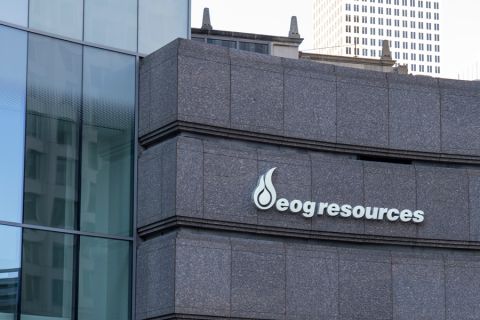
More than 35 years of exploitation and production history has defined northern Alaska as one of the most prolific oil-producing regions in the U.S. The area is currently producing about 550,000 barrels per day, has produced 17 billion barrels since first production in 1977, and has some 100 billion barrels of oil equivalent of discovered oil and gas in place.
The USGS estimates that Alaska’s North Slope and offshore areas contain more than 30 billion barrels and 200 trillion cubic feet of undiscovered conventional oil and gas resource. Furthermore, the North Slope is source rock-rich and holds the potential for considerable untapped unconventional resource.
Legacy fields on the North Slope are continuing their natural decline, leaving the Trans-Alaskan Pipeline system underutilized. Legislation passed in March 2013, the “More Alaskan Production Act” (S.B. 21), has taken significant steps to address declining production and encourage development by offering compelling incentives.
High exploration and development costs are subsidized by a very supportive Alaskan state government, resulting in near-industry-low seismic and exploration costs. In addition, tax credits are available for development capital and operating expenditures throughout the project life. Incentives also reward new production with generous tax relief.
The North Slope is a multipay region with historical development primarily focused on conventional oil fields along the Barrow Arch. The Kuparuk, Kingak and Brookian are prolific producing reservoirs along the Arch. These reservoirs extend well south and west of the currently producing fields and are current active exploration targets. The North Slope’s unconventional resource resides in three stacked source rocks: the Shublik Formation, Kingak Shale and the Hue/HRZ Shale.
Operations and transaction activity
Recent Alaska tax reform is a critical supporting factor in the development of oil and gas projects, where extreme climate conditions and geographical remoteness result in high operating costs. Horizontal drilling, multistage fracture stimulation and pad drilling are development practices currently used in Alaska.
Regional exploration 3-D seismic programs, which have increased in number and size in 2014, are necessary precursors for an active newfield exploration campaign.
Major North Slope operators like BP Plc and ConocoPhillips have increased capital spending for 2014 as a result of the new tax reform. ConocoPhillips has added two rigs and has announced plans for activity on several significant projects, including the advancement of viscous oil development targeting the West Sak in the Kuparuk River Unit, while beginning early stage work of its Greater Moose Tooth Unit in the National Petroleum Reserve. BP intends to allocate some of its 2014 capital for major long-term projects like the development of Liberty Field in the Beaufort Sea and the Point Thomson gas field.
Smaller North Slope operators like Great Bear Petroleum, Royale Energy, Rampart Energy and Armstrong Oil & Gas continue to be active, establishing joint ventures while exploring for con- ventional and unconventional opportunities. Great Bear has secured 500,000 acres south of Kuparuk and Prudhoe Bay fields. The company has drilled two wells and is evaluating an extensive 3-D dataset for both conventional and unconventional potential.
In May 2013, Rampart signed an agreement to earn up to 38,000 acres with Royale. Rampart’s interest in the area combines conventional upside (Kingak and Brookian) with its belief that the North Slope may provide one of the last significant shale plays in the U.S.
Repsol has a significant position on the North Slope and in the Beaufort and Chukchi Sea. Its North Slope assets are the result of a JV with Armstrong in 2011. Repsol announced three oil discov- eries in 2013 (Ougruk 1, 3 and 6) and has at least three new wells planned in 2014, in addition to acquiring 3-D seismic.
In October 2013, Pioneer Natural Resources sold its Alaskan assets to Caelus Energy LLC for $550 million. Pioneer’s main asset was Oooguruk Field. Recent Pioneer activity in nearby field extensions could add significant potential, particularly in the Torok Formation (Brookian). Caelus stated that it is attracted to Alaska due to the enormous geologic opportunity and financial incentives, including S.B. 21.
Northern Alaska has a great deal to offer, with a large volume of already discovered in-place reserves, some more challenging resources like heavy and viscous oil, and natural gas, plus enormous yet-to-be discovered resource potential.
Tim Pish is with Scotia Waterous.
Recommended Reading
The One Where EOG’s Stock Tanked
2024-02-23 - A rare earnings miss pushed the wildcatter’s stock down as much as 6%, while larger and smaller peers’ share prices were mostly unchanged. One analyst asked if EOG is like Narcissus.
EOG Resources Wildcatting Veteran Billy Helms to Retire
2024-04-02 - Joining an EOG Resources predecessor in 1981, Helms is among the pre-1986-oil-bust generation who later found success in shale.
In Shooting for the Stars, Kosmos’ Production Soars
2024-02-28 - Kosmos Energy’s fourth quarter continued the operational success seen in its third quarter earnings 2023 report.
Diamondback Stockholders All in for $26B Endeavor Deal
2024-04-29 - Diamondback Energy shareholders have approved the $26 billion merger with Endeavor Energy Resources.
CEO: Magnolia Hunting Giddings Bolt-ons that ‘Pack a Punch’ in ‘24
2024-02-16 - Magnolia Oil & Gas plans to boost production volumes in the single digits this year, with the majority of the growth coming from the Giddings Field.





